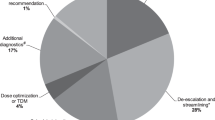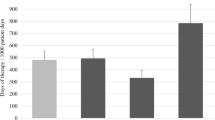Abstract
Antibiotic consumption (AC) is a key component of antimicrobial stewardship programs to recognize local patterns of antibiotic use. Our aim was to measure AC in neonatal units, including neonatal (NICU)/paediatric (PICU) intensive care units in different countries. We conducted a multicenter, retrospective, cohort study in three NICUs, one neonatal ward, and three PICUs with a total of 84 beds. Global and individual AC in days of therapy (DOT) and DOT per 1000 patient-days were assessed. During the study period, 2567 patients were admitted, corresponding to 4961 patient-days in neonatal units and 9243 patient-days in PICUs. Multidrug-resistant Gram-negative bacteria and methicillin-resistant Staphylococcus aureus were more frequent in Brazil than in Germany. Average AC was 386.5 and 1335.5 DOT/1000PD in German and Brazilian neonatal units, respectively. Aminopenicillins plus 3rd generation cephalosporins were the most commonly prescribed antibiotics in German neonatal units, while aminopenicillins plus aminoglycosides were the class most commonly used in Brazilian NICU. Average AC was 888.1 and 1440.7 DOT/1000PD in German and Brazilian PICUs, respectively. Antipseudomonal penicillins were most commonly used in the German PICU, and glycopeptides were the most frequently prescribed in Brazilian PICUs. Carbapenems represented 2.3–14% of total DOTs in German neonatal units and 4% in the Brazilian NICU and 13.0% in the German PICU and 6–12.2% in Brazilian PICUs. We concluded that different patterns of most commonly prescribed antibiotics were observed in neonatal units and PICUs in these two countries, probably related to different local patterns of antibiotic resistance, with a higher antibiotic consumption in Brazilian study units.
Similar content being viewed by others
References
Ting JY, Paquette V, Ng K, Lisonkova S, Hait V, Shivanada S et al (2019) Reduction of inappropriate antimicrobial prescriptions in a tertiary neonatal intensive care unit after antimicrobial stewardship care bundle implementation. Pediatr Infect Dis J 38:54–59. https://doi.org/10.1097/INF.0000000000002039
Kallen MC, Natsch S, Opmeer BC, Hulscher MEJL, Schouten JA, Prins JM et al (2019) How to measure quantitative antibiotic use in order to support antimicrobial stewardship in acute care hospitals: a retrospective observational study. Eur J Clin Microbiol Infect Dis 38:347–355. https://doi.org/10.1007/s10096-018-3434-0
Brotherton AL (2018) Metrics of antimicrobial stewardship programs. Med Clin N Am 102:965–976. https://doi.org/10.1016/j.mcna.2018.05.008
Diretriz Nacional para Elaboração de Programa de Gerenciamento do Uso de Antimicrobianos em Serviços de Saúde 2017. Agência Nacional de Vigilância Sanitária (ANVISA), Brasil. Available from: https://www20.anvisa.gov.br/segurancadopaciente/index.php/publicacoes/item/diretriz-nacional-para-elaboracao-de-programa-de-gerenciamento-do-uso-de-antimicrobianos-em-servicos-de-saude. [Accessed 14 Apr 2019]
Polk RE, Fox C, Mahoney A, Letcavage J, MacDougall C. Measurement of adult antibacterial drug use in 130 US hospitals: comparison of defined daily dose and days of therapy (2007) Clin. Infect. Dis.44:664–670.
Qu X, Yin C, Sun X, Huang S, Li C, Dong P et al (2018) Consumption of antibiotics in Chinese public general tertiary hospitals (2011-2014): trends, pattern changes and regional differences. PLoS One 13:e0196668. https://doi.org/10.1371/journal.pone.0196668 eCollection 2018
Wang A, Daneman N, Tan C, Brownstein JS, MacFadden DR (2017) Evaluating the relationship between hospital antibiotic use and antibiotic resistance in common nosocomial pathogens. Infect Control Hosp Epidemiol 38:1457–1463. https://doi.org/10.1017/ice.2017.222
WHO Collaborating Centre for Drug Statistics Methodology, Guidelines for ATC classification and DDD assignment 2019. Oslo (Norway): 2018. Available from: https://www.whocc.no/atc_ddd_index_and_guidelines/guidelines/. [Accessed 14 Apr 2019]
Kreitmeyr K, von Both U, Pecar A, Borde JP, Mikolajczyk R, Huebner J (2017) Pediatric antibiotic stewardship: successful interventions to reduce broad-spectrum antibiotic use on general pediatric wards. Infection. 45:493–504. https://doi.org/10.1007/s15010-017-1009-0
Koopmans LR, Finlayson H, Whitelaw A, Decloedt EH, Dramowski A (2018) Paediatric antimicrobial use at a South African hospital. Int J Infect Dis 74:16–23. https://doi.org/10.1016/j.ijid.2018.05.020
World Health Organization. Antimicrobial resistance. Geneve,2018. Available from: http://www.who.int/mediacentre/factsheets/fs194/en/ [Accessed 15 Feb 2019].
Aizawa Y, Suwa J, Higuchi H, Fukouka K, Furuichi M, Kaneko T et al (2018) Antimicrobial stewardship program in a pediatric intensive care unit. J Pediatric Infect Dis Soc 7:e156–e159. https://doi.org/10.1093/jpids/piy031
Siegel JD, Rhinehart E, Jackson M, and the Healthcare Infection Control Practices Advisory Committee, 2007 Guideline for Isolation precautions: preventing transmission of infectious agents in healthcare settings, centers for disease control, USA. June 2007
Magiorakos AP, Srinivasan A, Carey RB, Carmeli Y, Falagas ME, Giske CG et al (2012) Multidrug-resistant, extensively drug-resistant and pandrug-resistant bacteria: an international expert proposal for interim standard definitions for acquired resistance. Clin Microbiol Infect 18:268–281. https://doi.org/10.1111/j.1469-0691.2011.03570.x
Huebner J, Rack-Hoch AL, Pecar A, Schmid I, Klein C, Borde JP (2013) Pilot project of a pediatric antibiotic stewardship initiative at the Hauner children’s hospital. Klin Padiatr 225:223–229. https://doi.org/10.1055/s-0033-1349063
Galankin TL, Kolbin AS, Sidorenko SV, Kurylev AA, Malikova EA, Lobzin YV et al (2018) Retrospective surveillance of antibiotic use in maternity wards and neonatal intensive care units in Saint Petersburg, Russia. Eur J Clin Microbiol Infect Dis 37:1531–1537. https://doi.org/10.1007/s10096-018-3280-0
Cantey JB, Wozniak PS, Pruszynski JE, Sánchez PJ (2016) Reducing unnecessary antibiotic use in the neonatal intensive care unit (SCOUT): a prospective interrupted time-series study. Lancet Infect Dis 16:1178–1184. https://doi.org/10.1016/S1473-3099(16)30205-5
Agência Nacional de Vigilância Sanitária, Brasil. Boletim Segurança do Paciente e Qualidade em Serviços de Saúde n°17: Avaliação dos indicadores nacionais das Infecções Relacionadas à Assistência à Saúde (IRAS) e Resistência microbiana do ano de 2017. Brasília, 2019. Available from: https://www20.anvisa.gov.br/segurancadopaciente/index.php/publicacoes/category/boletins-estatisticos. [Accessed 5 May 2019]
European Center for Disease Control and Prevention. Surveillance of antimicrobial resistance in Europe 2017. Stockolm, 2019. Available from: https://ecdc.europa.eu/sites/portal/files/documents/EARS-Net-report-2017-update-jan-2019.pdf [Accessed 5 May 2019]
Ding H, Yang Y, Wei J, Fan S, Yu S, Yao K et al (2008) Influencing the use of antibiotics in a Chinese pediatric intensive care unit. Pharm World Sci 30:787–793. https://doi.org/10.1007/s11096-008-9220-9
Acknowledgments
We thank ME Guimarães Viana (Director of Prontobaby and Centro Pediátrico da Lagoa) for your support.
Author information
Authors and Affiliations
Corresponding author
Ethics declarations
Conflict of interest
The authors declared that they have no conflict of interest.
Ethical approval
Formal ethical approval was obtained from the research ethics committee of the LMU Munich (ID 404-14) and national Brazilian Committee (CAEE 69902317.3.0000.5243, 15/09/2017)
Additional information
Publisher’s note
Springer Nature remains neutral with regard to jurisdictional claims in published maps and institutional affiliations.
Rights and permissions
About this article
Cite this article
Araujo da Silva, A.R., Jaszkowski, E., Schober, T. et al. Patterns of antimicrobial consumption in neonatal and pediatric intensive care units in Germany and Brazil. Eur J Clin Microbiol Infect Dis 39, 249–255 (2020). https://doi.org/10.1007/s10096-019-03714-9
Received:
Accepted:
Published:
Issue Date:
DOI: https://doi.org/10.1007/s10096-019-03714-9




